USB 3.2 Gen 2x2 State of the Ecosystem Review: Where Does 20Gbps USB Stand in 2020?
by Ganesh T S on October 5, 2020 10:30 AM EST- Posted in
- Storage
- SSDs
- Western Digital
- SanDisk
- ASMedia
- USB 3.2 Gen 2x2
PCMark 10 Storage Bench - Real-World Access Traces
There are a number of storage benchmarks that can subject a device to artificial access traces by varying the mix of reads and writes, the access block sizes, and the queue depth / number of outstanding data requests. We saw results from two popular ones - ATTO, and CrystalDiskMark - in a previous section. More serious benchmarks, however, actually replicate access traces from real-world workloads to determine the suitability of a particular device for a particular workload. Real-world access traces may be used for simulating the behavior of computing activities that are limited by storage performance. Examples include booting an operating system or loading a particular game from the disk.
PCMark 10's storage bench (introduced in v2.1.2153) includes four storage benchmarks that use relevant real-world traces from popular applications and common tasks to fully test the performance of the latest modern drives:
- The Full System Drive Benchmark uses a wide-ranging set of real-world traces from popular applications and common tasks to fully test the performance of the fastest modern drives. It involves a total of 204 GB of write traffic.
- The Quick System Drive Benchmark is a shorter test with a smaller set of less demanding real-world traces. It subjects the device to 23 GB of writes.
- The Data Drive Benchmark is designed to test drives that are used for storing files rather than applications. These typically include NAS drives, USB sticks, memory cards, and other external storage devices. The device is subjected to 15 GB of writes.
- The Drive Performance Consistency Test is a long-running and extremely demanding test with a heavy, continuous load for expert users. In-depth reporting shows how the performance of the drive varies under different conditions. This writes more than 23 TB of data to the drive.
Despite the data drive benchmark appearing most suitable for testing direct-attached storage, we opted to run the full system drive benchmark as part of our evaluation flow. Many of us use portable flash drives as boot drives and storage for Steam games. These types of use-cases are addressed only in the full system drive benchmark.
The Full System Drive Benchmark comprises of 23 different traces. For the purpose of presenting results, we classify them under five different categories:
- Boot: Replay of storage access trace recorded while booting Windows 10
- Creative: Replay of storage access traces recorded during the start up and usage of Adobe applications such as Acrobat, After Effects, Illustrator, Premiere Pro, Lightroom, and Photoshop.
- Office: Replay of storage access traces recorded during the usage of Microsoft Office applications such as Excel and Powerpoint.
- Gaming: Replay of storage access traces recorded during the start up of games such as Battlefield V, Call of Duty Black Ops 4, and Overwatch.
- File Transfers: Replay of storage access traces (Write-Only, Read-Write, and Read-Only) recorded during the transfer of data such as ISOs and photographs.
PCMark 10 also generates an overall score, bandwidth, and average latency number for quick comparison of different drives. The sub-sections in the rest of the page reference the access traces specified in the PCMark 10 Technical Guide.
Booting Windows 10
The read-write bandwidth recorded for each drive in the boo access trace is presented below.
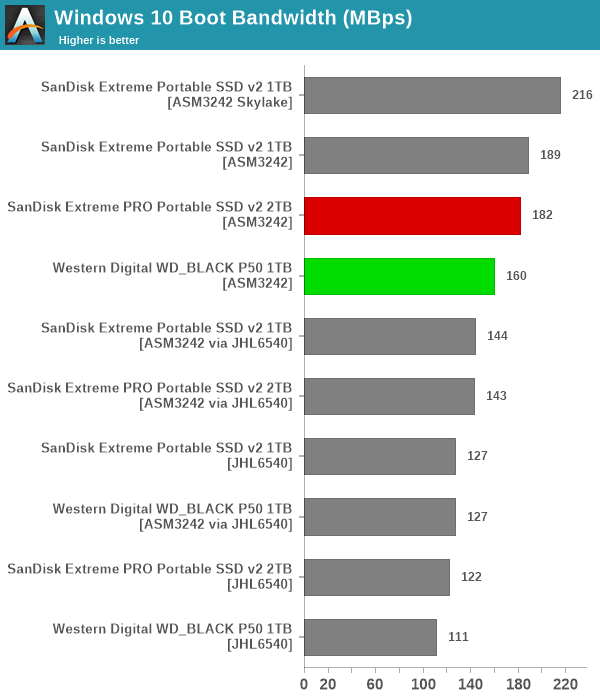
USB SuperSpeed 20Gbps doesn't matter for the boot process - in fact, the Extreme Portable SSD v2 using the SN550E behind a USB 3.2 Gen 2 (10 Gbps) bridge scores better than the P50 and the Extreme PRO v2 on the Haswell testbed in this benchmark.
Creative Workloads
The read-write bandwidth recorded for each drive in the sacr, saft, sill, spre, slig, sps, aft, exc, ill, ind, psh, and psl access traces are presented below.
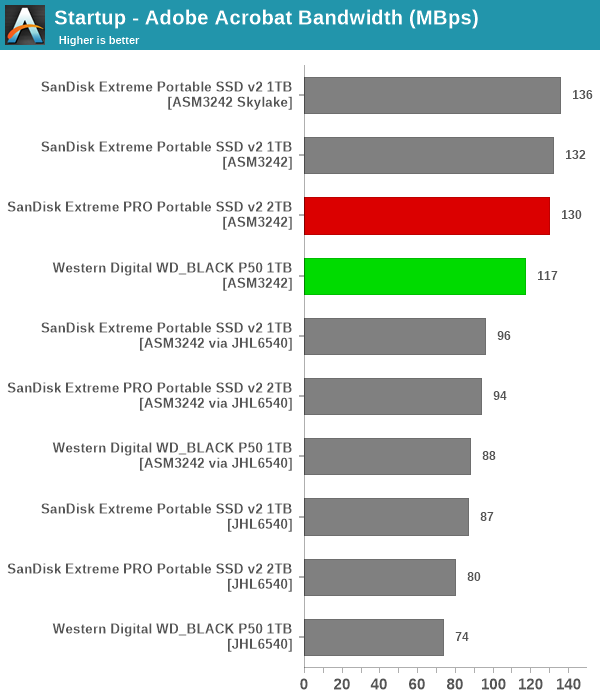
These workloads also seem to get little benefit from the move to USB SuperSpeed 20Gbps. In almost all cases, the SanDisk Extreme v2 performs better than the Extreme PRO v2 on the same testbed. The P50 seems to suffer from some handicaps for these types of workloads.
Office Workloads
The read-write bandwidth recorded for each drive in the exc and pow access traces are presented below.
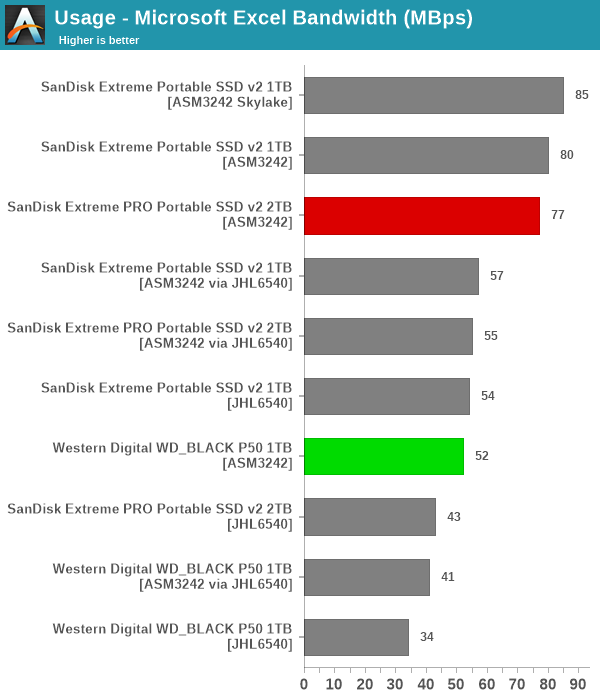
The trend seen in earlier PCMark 10 storage workloads repeats here - the Extreme edging out the Extreme PRO v2 slightly, while the P50 lags well behind.
Gaming Workloads
The read-write bandwidth recorded for each drive in the bf, cod, and ow access traces are presented below.
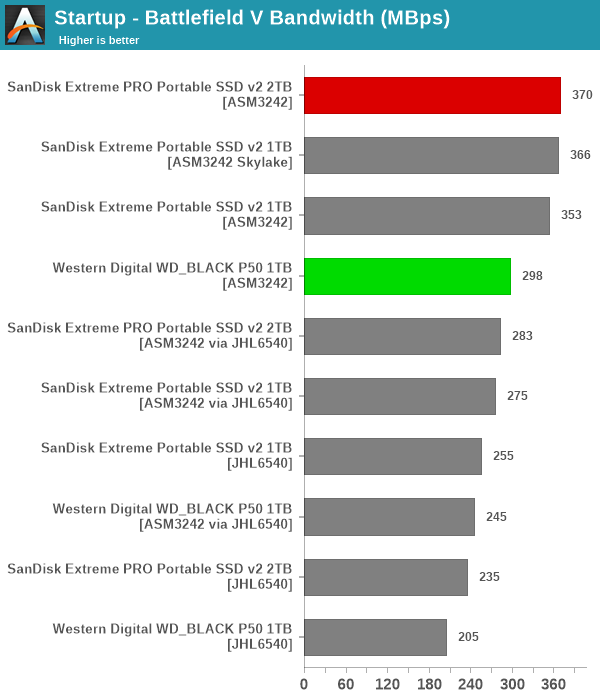
This section finally sees the P50 live up to its billing as a game drive - in the Call of Duty loading times, it finally scores almost as well as the Extreme PRO v2, and the Extreme v2 lags well behind. However, overall, the Extreme PRO v2 seems to be a better fit for gaming workloads.
Files Transfer Workloads
The read-write bandwidth recorded for each drive in the cp1, cp2, cp3, cps1, cps2, and cps3 access traces are presented below.
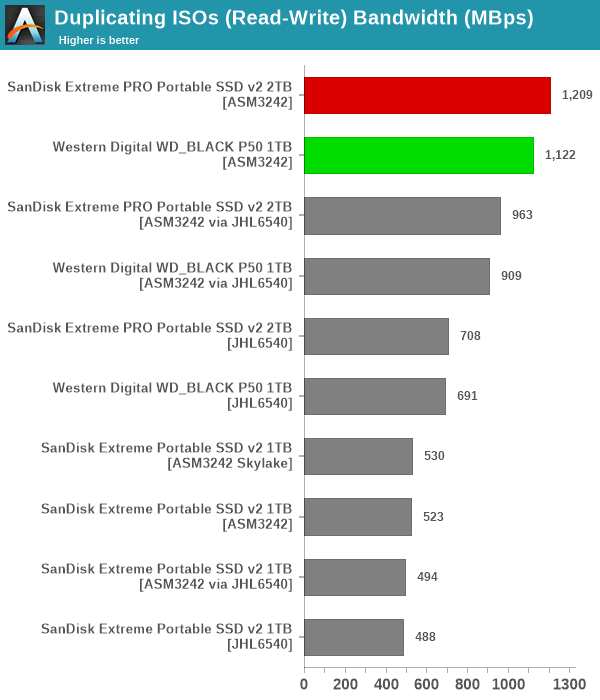
In most workloads, the USB SuperSpeed 20Gbps drives come out on top, with the Extreme PRO v2 slightly edging out the P50.
Overall Scores
PCMark 10 reports an overall score based on the observed bandwidth and access times for the full workload set. The score, bandwidth, and average access latency for each of the drives are presented below.
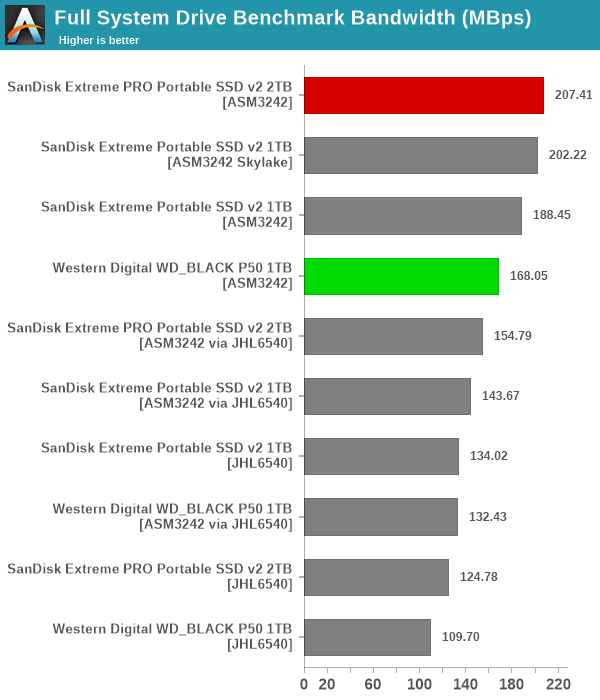
The WD_BLACK P50 scores are a bit behind the Extreme PRO v2 and the Extreme v2 when considered on a testbed-by-testbed basis. When limited by the host port to 10Gbps, the gulf is not significant, though. It may just be that Western Digital has tweaked the firmware of the P50 to cater to gaming workloads alone.










81 Comments
View All Comments
CaptainChaos - Monday, October 5, 2020 - link
Seems to me this whole fiasco is just an inevitable merge of USB (dumb/cheap interface) to Thunderbolt (smart-ish/expensive interface) to produce a middle-of-the-road option. Just how far can we go with the only choice of cheap & dumb vs smart & expensive? When the dust settles in a couple years we'll all be more-or-less happy and the next, greatest thing will be all over the tech news!!hubick - Tuesday, October 6, 2020 - link
Thunderbolt is essentially proprietary to Intel, and without Intel supporting USB 3.2 2x2, that makes 2x2 essentially proprietary to AMD. Did anyone ever release a JHL7440 based Thunderbolt 3 SSD that's actually compatible with regular USB-C ports? Cuz at least a USB 3.2 2x2 drive will *work* when plugged in to an Intel (Thunderbolt 3/USB4) system port, whereas most Thunderbolt drives won't even connect to an AMD (USB 3.2 2x2) system port.hubick - Sunday, November 29, 2020 - link
The LaCie "Rugged SSD Pro" (STHZ1000800 & STHZ2000800) appear to be the first JHL7440 based Thunderbolt SSD with USB fallback support.R3MF - Tuesday, October 6, 2020 - link
Have we had any indication of launch dates for USB4 controller chips?And any indication of the lag between launch and products utilising them arriving on shelves?
repoman27 - Tuesday, October 6, 2020 - link
Intel has already “launched” Tiger Lake CPUs with integrated Thunderbolt 4 / USB4 as well as the Goshen Ridge 4-port hub/device and a couple retimer chips. Additionally, they announced the Maple Ridge host controllers which will be available “later this year”. I’d reckon we’ll also see Apple Silicon Macs with Thunderbolt 4 / USB4 by the end of the year.R3MF - Tuesday, October 6, 2020 - link
Hmmm, really thinking about the thired party controller chips that are likely to be integrated into motherboards and drives on non-Tigerlake platforms.Much as the Asmedia chip is used today to add 2x2 (after being announced on AT about 18 months ago).
repoman27 - Tuesday, October 6, 2020 - link
That’d be the aforementioned Maple Ridge chips.I’d have to imagine ASMedia and AMD have something in the works, but to my knowledge they haven’t said anything publicly. Which means Intel and Apple are probably going to have a significant head start with Thunderbolt 4, and Intel will be the only source for discrete USB4 silicon for a while.
Tomatotech - Tuesday, October 6, 2020 - link
Dancing_coffin_pallbearers.gif🕺🏻🕺🏻 ⚰️ 🕺🏻 🕺🏻
Apologies for the emoji, but I don’t see how this USB 3.2 Gen 2x2 standard will ever take off given the travails and issues described in the article. Best to kill it and bury it somewhere deep.
PeachNCream - Tuesday, October 6, 2020 - link
"USB has emerged as the mainstream interface of choice for data transfer from computing platforms to external storage devices."The opening line made me laugh a little since USB has been the dominant PC interface for a solid 15 years now.
Mitch89 - Tuesday, October 6, 2020 - link
Honestly, what on earth was the thinking behind the ridiculous naming (and renaming) of the USB versions?It used to be simple and clear, but now, between the crazy naming and mess that is USB-C (is it USB or Thunderbolt? Is the cable USB 2, 3, 3.1 Gen 2? Does it support 100W power?), how is anyone supposed to make sense on it.